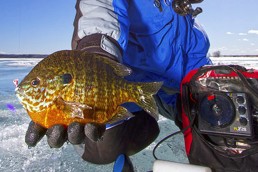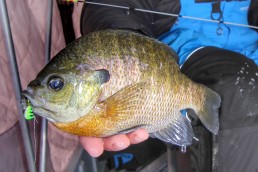The Right ‘Pitch’ for Panfish
SHARE THIS POST
When it comes to presentation discussion concerning bluegills, tungsten has dominated the discussions over the past few years. Tungsten jigs have become so popular because the metal is much heavier than traditional lead.
An angler can go a couple different directions with tungsten. You can use a much smaller profile or size with tungsten, or you can use the same mass or size as traditional lead, but there is also increased sensitivity because of the increase in weight. The extra weight not only increases sensitivity, but also seems to give more action or kick to traditional soft plastics and also displaces water better for putting out a cadence that “calls” fish in. If you want to see a very well thought out lineup of tungsten for bluegills, check out Dave Genz’s Clam Tackle Drop Series of tungsten jigs.
Typically, the drop jigs are the answer for most fish—heavy enough for getting back down through the water column fast. It’s a great choice for the first drop down the hole. The tungsten jigs cut through slush well, and maintain sensitivity in the elements when wind is pushing the line around. Both sensitive and fast, there is not much not to dislike about tungsten. That is, until fish start to stall out before they get to you. As anglers, we have to find a balance between efficiency and effectiveness. This balance becomes extremely evident with sunfish.
Tungsten rocks when fish are in at least a neutral mood and want to eat. Often, the first look fish give you is often going to be the best. And after you wear out your welcome, you will see fish stall as they come in on you, especially with no acceleration or rise in the water column. When fish get “tough” they peddle real slowly up to the presentation and analyze it from a distance, essentially stopping off the lure. Fishing pressure is the usual culprit making it difficult to trigger fish.
There are situations where you won’t get bit if you use line heavier than 2-pound-test. There are bites that require extreme finesse. The action on the jig has to be controlled with the most delicate “dabble” to float the jig without any twisting or spinning. Ultralight spring bobbers, 1-pound monofilament and micro-size jigs can make a big difference in catching fish. When things get really tough, move away from tungsten and incorporate presentations that drop or hang slowly down through the water column. Imagine pinching a waxworm and dropping it in the hole. The waxworm falls painstakingly slow down the hole and takes forever to drift slowly toward the bottom. This ultra-slow descent usually snaps the self-restraint of any bluegills in the area.
Are you enjoying this post?
You can be among the first to get the latest info on where to go, what to use and how to use it!
How can you mimic this descent? There are a couple of options. Where legal, a very effective method is to tie a small, wet nymph a few feet above the jig using a loop knot-tied inline. This method is extremely deadly over the tops of weeds. Simply lay the bottom jig on the weed stalks and let the wet nymph do the slow descent on semi-slack line. Sometimes referred to as a “Michigan Rig” in some parts of the country, this ice fishing variation of a drop-shot rig can also be modified to use a plain hook and soft plastic.
In water less than 10 feet, another option to accomplish this descent is to simply free fall a small plain hook rigged with a soft plastic so that the action is smooth and sliding as the plastic falls through the water column—no quivering or pounding to get the lure to kick and dance, the action is simply the slow descent itself, painstakingly slow, but seductive. An ultra-slow drop will catch the most difficult fish left in a school, even fish that have previously been hooked or rolled.
Because this presentation wrinkle is slow and sometimes tedious, this is not necessarily the best strategy to start in a hole or spot, and is definitely not the best choice for finding fish.
What this finesse tactic will do however is round you out as a more “complete” angler. The more tools and presentations you have to throw at fish, the more effective you will be. On a typical school of fish, we will often start out using tungsten, and then as conditions get more difficult and we start to wear out our welcome in a spot, we can pull more fish off the spot with some of these finesse tactics described. In some areas where there is intense fishing pressure, anglers have to shift to some of these strategies much sooner.
If you have yet to embrace the new tungsten jigs, I strongly encourage you to do so and also recognize the situations where tungsten can be put to best use. A pitcher in baseball has to have more than one pitch; the slow-fall finesse game is the fisherman’s change-up “pitch.” Master both “pitches” and you are on your way to “striking out” (catching) a lot more big bluegills and sunfish this winter.
MWO
SHARE THIS POST
Did you enjoy this post?
You can be among the first to get the latest info on where to go, what to use and how to use it!
Jason Mitchell
Jason Mitchell was a top walleye guide on Devils Lake, N.D. for nearly 20 years. Today, Mitchell produces the Jason Mitchell Outdoors TV program. Visit jasonmitchelloutdoors.com for more.



